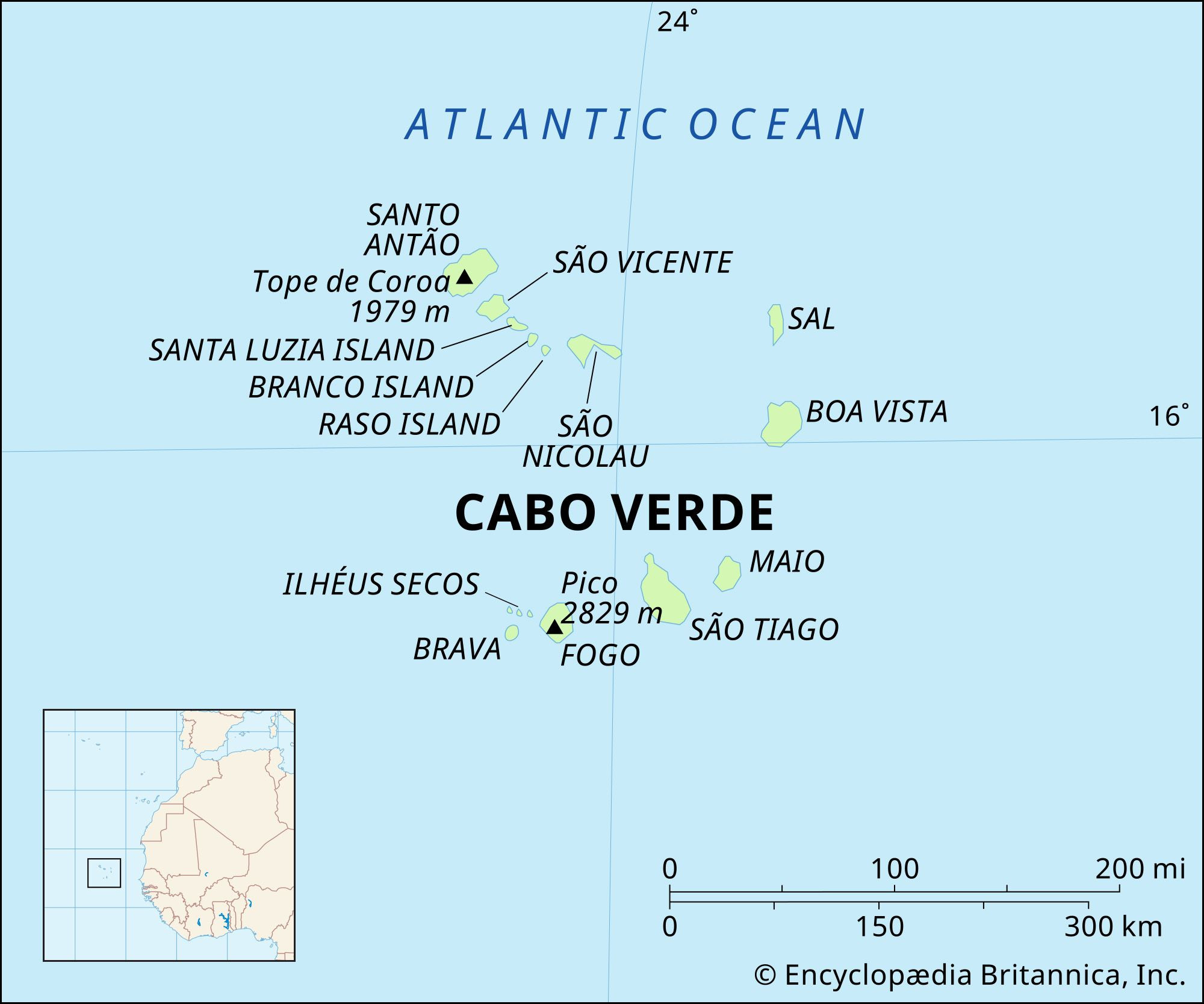Cape Verde, or Cabo Verde, is an island nation that often sparks curiosity about its location. Many wonder, Where Is Cape Verde exactly? This archipelago, brimming with diverse landscapes and vibrant culture, is situated in the Atlantic Ocean, off the coast of West Africa.
 Physical features of Cabo Verde
Physical features of Cabo Verde
The physical features of Cabo Verde showcase its volcanic origins and strategic location in the Atlantic.
Comprising ten islands and several islets, Cape Verde lies between 14°30′ and 17°30′ N latitude and 22°30′ and 25°30′ W longitude. For those pinpointing Cape Verde location on a map, it’s approximately 385 miles (620 kilometers) west of Senegal. This puts it within the same approximate latitude as countries in the Sahara Desert, influencing its climate and landscape.
The archipelago is naturally divided into two groups: the Barlavento (Windward) Islands to the north and the Sotavento (Leeward) Islands to the south. The Barlavento group includes Santo Antão, São Vicente, the uninhabited Santa Luzia, São Nicolau, Sal, and Boa Vista, along with the islets of Raso and Branco. The Sotavento Islands consist of Maio, Santiago, Fogo, and Brava, plus the Rombos islets—Grande, Luís Carneiro, and Cima. Each island within Cape Verde islands offers unique geographical characteristics.
Diverse Terrain and Landscape of Cape Verde
The geography of Cape Verde is remarkably varied. The eastern islands like Boa Vista, Maio, and Sal, being geologically older, present flatter landscapes characterized by sandy expanses due to significant wind erosion over millennia. These Cape Verde eastern islands are in stark contrast to the western islands, which are younger and more mountainous, exhibiting rugged and dramatic terrains.
Fogo Island, aptly named “Fire,” is home to Pico, an active volcano and the highest point in Cape Verde, reaching 9,281 feet (2,829 meters). On Santo Antão, the northernmost large island in Cape Verde archipelago, Tope de Coroa stands tall at 6,493 feet (1,979 meters), showcasing the mountainous nature of the western islands.
Water is a precious resource in Cape Verde. Permanent watercourses are scarce, and the islands grapple with seasonal rains, recurring droughts, and persistent water scarcity. When rainfall does occur, it often comes in intense bursts, leading to soil erosion, flooding, and damage to water containment structures. The soils, primarily volcanic, are generally shallow, coarse, and rocky. Basalt is a common rock type, reflecting the volcanic origins of Cape Verde geography. A significant portion of the land is arid, suitable mainly for grazing, with limited areas having fertile soil and sufficient water for substantial agriculture.
Climate: Aridity and the Intertropical Convergence Zone
The climate in Cape Verde Africa is generally moderate but significantly arid, marked by stable temperatures. February is the coolest month, with temperatures around the low 70s Fahrenheit (low 20s Celsius). August and September are the hottest and wettest, with temperatures in the low 80s Fahrenheit (high 20s Celsius).
The island of São Vicente in Cape Verde exemplifies the archipelago’s diverse coastal and volcanic landscapes.
A key climatic influence is the intertropical convergence zone (ITCZ), which brings a two-season pattern. Winter winds from Europe are cool and dry. In summer, the ITCZ shifts northward, and the Guinea Current brings warmth and moisture, potentially increasing rainfall, especially in the higher elevations of the mountainous islands. However, precipitation remains unpredictable, and years can pass with minimal rainfall. The meeting of air masses near Cape Verde islands location also contributes to the formation of hurricanes that track westward across the Atlantic towards the Caribbean and the eastern United States.
Unique Plant and Animal Life in Cape Verde
Despite the arid conditions, Cape Verde’s location and varied altitudes support diverse plant and animal life. The windward slopes of the larger, higher islands receive enough precipitation to support grasses and some pine plantations. Leeward slopes, however, experience a rain-shadow effect, leading to desert-like conditions with sparse, often thorny or toxic shrubs. Agriculture is limited to higher elevations or intensely terraced valleys. Xerophilous plants, adapted to desert conditions, thrive in the brackish subsoil of islands like Maio, Sal, and Boa Vista.
Water scarcity limits land turtles, but sea turtles utilize the sandy shores of uninhabited islets for nesting. Geckos, lizards, and skinks are common, including the endangered giant skink. Butterflies are present, though not endemic, originating from Africa.
Over 100 bird species have been identified, with petrels and shearwaters among the regular breeders. Other notable birds include flamingos, frigate birds, buzzards, Egyptian vultures, kites, and tropic birds. The cane warbler and Raso lark are endemic species, the latter unique to the islet of Raso. Interestingly, gulls and terns do not breed in Cape Verde islands Africa.
Mammals include feral goats on Fogo, descendants of domestic goats. Rodents likely arrived on early ships, and monkeys were introduced from the African continent. The long-eared bat is the only indigenous mammal.
In conclusion, Cape Verde’s location off the coast of West Africa in the Atlantic Ocean defines its unique geography, climate, and biodiversity. From volcanic peaks to sandy plains, and a blend of African and oceanic influences, Cape Verde stands as a fascinating archipelago with much to explore.

 São Vicente Island
São Vicente Island